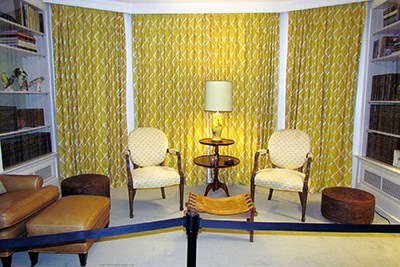Last updated: September 27, 2025
Article
The Great Freeze: Remediating Mold and Pests at the Texas White House Complex

In 2016 staff at Lyndon B. Johnson National Historical Park began noticing a slow deterioration of the environmental conditions inside the Texas White House. As early as 2009, the Park’s Curatorial team started spot-cleaning artifacts affected by small patches of mold, a common problem in the Texas Hill Country due to high humidity. But the discovery of black mold on walls in the Texas White House was a game changer. Black mold can cause severe health conditions in people, and this, along with structural issues that created safety concerns, led to the closure of the Texas White House in 2018.
The decision to temporarily close the home to the public provided an opportunity for the Curatorial team to meticulously survey each object. In addition to signs of mold, they discovered pest infestations that were causing damage, especially to textiles and books. The team researched treatment options and developed a remediation and conservation plan. From 2021 to 2025 this major conservation effort for the Texas White House preserved over 610 historic textiles (heavy drapes, lightweight curtains, clothing, and linens) and 1,443 books owned by the Johnson Family.
The Curatorial team is responsible for the day-to-day protection and preservation of the collection. The conservation plan they developed and implemented included cold storage and freezing for specific object types. They identified freezing times, cleaning techniques, and long-term storage locations for all types of textiles and books. Using the Park’s side-by-side industrial refrigerator and freezer, items chosen for cold treatment were carefully sealed and refrigerated or frozen for at least 30 days to eliminate pests and arrest mold growth. Once removed and acclimated, each textile was surface cleaned using HEPA-filtered vacuums and protective equipment to remove debris and reduce mold spores. The treated textiles and books are now stabilized and safely stored in clean, climate-controlled facilities. A dedicated team of five Park staff members carried out the project on-site, ensuring the long-term preservation of these original materials.
The decision to temporarily close the home to the public provided an opportunity for the Curatorial team to meticulously survey each object. In addition to signs of mold, they discovered pest infestations that were causing damage, especially to textiles and books. The team researched treatment options and developed a remediation and conservation plan. From 2021 to 2025 this major conservation effort for the Texas White House preserved over 610 historic textiles (heavy drapes, lightweight curtains, clothing, and linens) and 1,443 books owned by the Johnson Family.
The Curatorial team is responsible for the day-to-day protection and preservation of the collection. The conservation plan they developed and implemented included cold storage and freezing for specific object types. They identified freezing times, cleaning techniques, and long-term storage locations for all types of textiles and books. Using the Park’s side-by-side industrial refrigerator and freezer, items chosen for cold treatment were carefully sealed and refrigerated or frozen for at least 30 days to eliminate pests and arrest mold growth. Once removed and acclimated, each textile was surface cleaned using HEPA-filtered vacuums and protective equipment to remove debris and reduce mold spores. The treated textiles and books are now stabilized and safely stored in clean, climate-controlled facilities. A dedicated team of five Park staff members carried out the project on-site, ensuring the long-term preservation of these original materials.
If the Drapes Could Talk: Yellow Sitting Room Has it All

In 1967 the Johnsons remodeled this former master bedroom into a sitting room in Georgian revival style to reflect Lady Bird’s taste in design. Here she would play bridge, watch her favorite television shows, and visit with friends. More formally, she would use the space to host reporters, authors, and journalists who interviewed her through the years.
The Yellow Sitting Room also held a meeting of historical significance on January 7, 1968. President Lyndon Johnson and Israeli Prime Minister Levi Eshkol met there to discuss the fragile peace and security in the Middle East. It was part of Eshkol's state visit to the US following the 1967 Six-Day War. Their talks set the stage for continued US consideration of Israel's defense needs and cooperation on finding a path to peace in the region.

LBJ Library / Yoichi Okamoto
